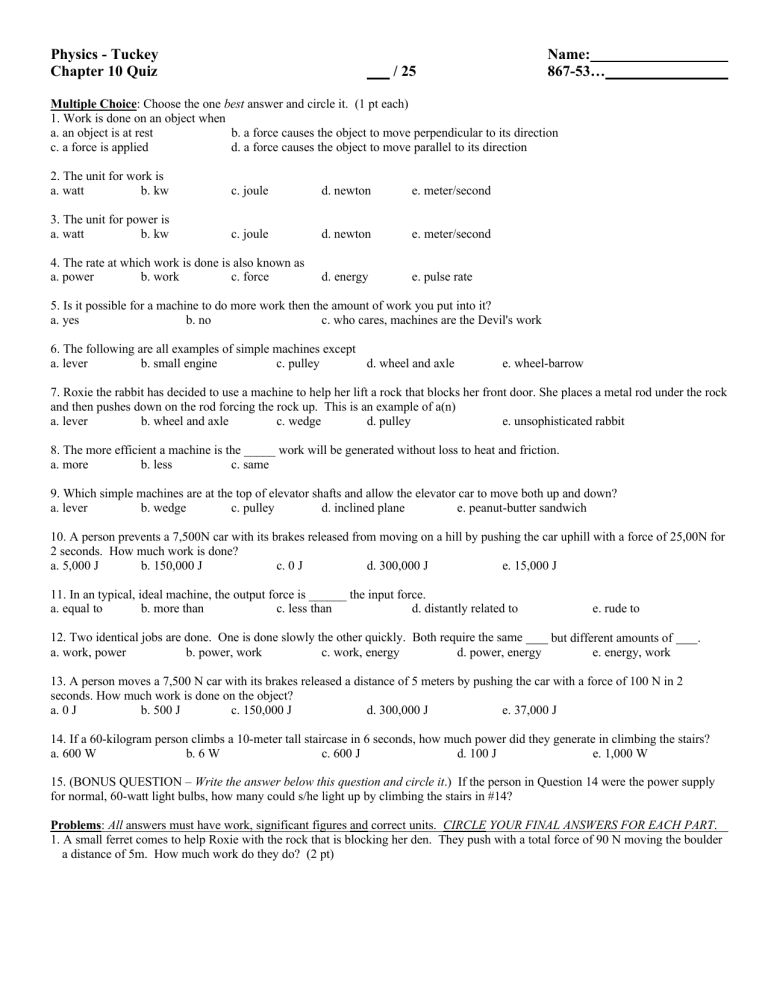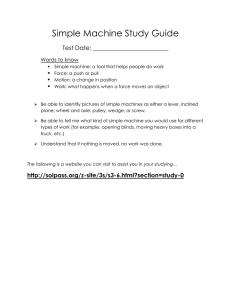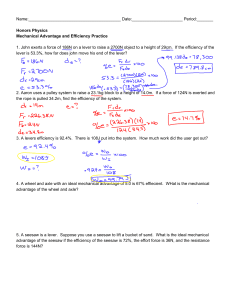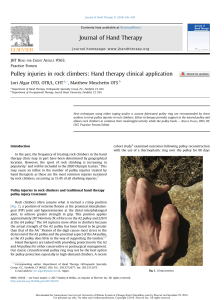Chapter 10 Quiz

Physics - Tuckey Name:
Chapter 10 Quiz / 25 867-53…
Multiple Choice : Choose the one best answer and circle it. (1 pt each)
1. Work is done on an object when a. an object is at rest b. a force causes the object to move perpendicular to its direction c. a force is applied d. a force causes the object to move parallel to its direction
2. The unit for work is a. watt b. kw c. joule d. newton e. meter/second
3. The unit for power is a. watt b. kw c. joule d. newton e. meter/second
4. The rate at which work is done is also known as a. power b. work c. force d. energy e. pulse rate
5. Is it possible for a machine to do more work then the amount of work you put into it? a. yes b. no c. who cares, machines are the Devil's work
6. The following are all examples of simple machines except a. lever b. small engine c. pulley d. wheel and axle e. wheel-barrow
7. Roxie the rabbit has decided to use a machine to help her lift a rock that blocks her front door. She places a metal rod under the rock and then pushes down on the rod forcing the rock up. This is an example of a(n) a. lever b. wheel and axle c. wedge d. pulley e. unsophisticated rabbit
8. The more efficient a machine is the _____ work will be generated without loss to heat and friction. a. more b. less c. same
9. Which simple machines are at the top of elevator shafts and allow the elevator car to move both up and down? a. lever b. wedge c. pulley d. inclined plane e. peanut-butter sandwich
10. A person prevents a 7,500N car with its brakes released from moving on a hill by pushing the car uphill with a force of 25,00N for
2 seconds. How much work is done? a. 5,000 J b. 150,000 J c. 0 J d. 300,000 J e. 15,000 J
11. In an typical, ideal machine, the output force is ______ the input force. a. equal to b. more than c. less than d. distantly related to e. rude to
12. Two identical jobs are done. One is done slowly the other quickly. Both require the same but different amounts of . a. work, power b. power, work c. work, energy d. power, energy e. energy, work
13. A person moves a 7,500 N car with its brakes released a distance of 5 meters by pushing the car with a force of 100 N in 2 seconds. How much work is done on the object? a. 0 J b. 500 J c. 150,000 J d. 300,000 J e. 37,000 J
14. If a 60-kilogram person climbs a 10-meter tall staircase in 6 seconds, how much power did they generate in climbing the stairs? a. 600 W b. 6 W c. 600 J d. 100 J e. 1,000 W
15. (BONUS QUESTION – Write the answer below this question and circle it .) If the person in Question 14 were the power supply for normal, 60-watt light bulbs, how many could s/he light up by climbing the stairs in #14?
Problems : All answers must have work, significant figures and correct units. CIRCLE YOUR FINAL ANSWERS FOR EACH PART .
1. A small ferret comes to help Roxie with the rock that is blocking her den. They push with a total force of 90 N moving the boulder a distance of 5m. How much work do they do? (2 pt)
2. How much power does a crane lifting 250 N a distance of 150 m up in 30.0 seconds need to generate? (3 pt)
3. I pull a crate (there he goes with the “crate” obsession again…) with a rope along the floor at a constant speed. If I pull with a force of 260 N while the rope makes an angle of 60.0º with the flat surface of the floor, what distance would I need to cover in order to generate 1.0 kW (1,000 watts) in 5.0 seconds? (3 pt)
4. Suppose that a car with a miracle engine is 100% efficient with the work it does. This implies that about 150 million joules of work per gallon of gasoline is done. If the air drag and overall frictional forces on this car traveling at its optimal, constant cruising speed on the highway is 2.0 x 10
2
N (a very reasonable estimate), what is the upper limit in distance per gallon that such a car could cover at that constant speed? [ Hint: Once at the optimal cruising speed, the only force the car engine would have to exert would be enough to overcome all forms of friction. And the energy released by the fuel would all go to doing work.
] What does this tell you about fuel efficiency of “normal” gasoline engines at the present time? [Recall: 1 mile = 1.609 km] (3 pt)





